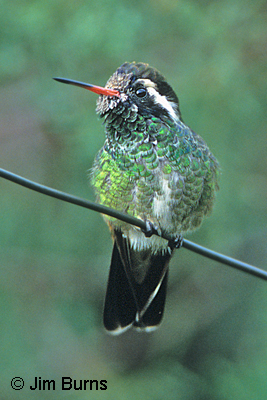
Instantly recognized by their small size, their long, thin bills, and the hum of their wings in flight, hummers' unique ability to hover in place and fly up, down, sideways, and backwards is attributable to the figure eight motion of their wings. Additionally they have long, extensible tongues specially grooved to draw nectar from flower to mouth by capillary action.
Known for their frenetic foraging activity during which their heart rate can reach 1250(!) beats per minute, on cold nights hummers can enter a state of torpor, conserving energy with as few as 50 beats per minute. And though our female hummingbirds are just green over gray, most species' adult males are adorned with spectacularly iridescent feathers on their throat and forehead which run from the color wheel from electric blue through ruby red to copper gold. The hummingbird throat is referred to as a gorget, pronounced GORE-jet, derived from the protective throat piece on suits of armor.
Looking for a place to beat the summer heat and see some cool birds? The hotspot for Arizona's hummer activity is three canyons on the east flank of the Huachuca Mountain range just south of Sierra Vista, and the peak of this activity is the third week of August.
The first canyon driving south out of Sierra Vista is Ramsey, the most famous and home to the Nature Conservancy's Ramsey Canyon Preserve. In August it is open 8 to 5 daily with an entrance fee of $5. The Ramsey Canyon Inn (ramseycanyoninn.com; 520-378-3010) is just outside the preserve's gate. This year a pair of berylline hummingbirds, large, beautiful, and uncommon, are being seen at flowers and feeders both at the inn and inside the preserve.
Miller is the next canyon to the south, and at the terminus of the graveled road is Beatty's Miller Canyon Guest Ranch & Orchard (beattysguestranch.com; 520-378-2728). Owner Tom Beatty graciously allows non-guest access to one of his feeding areas, but a donation to his "sugar jar" is suggested. For over a decade Beatty's has been the only reliable spot north of Mexico to see the spectacular white-eared hummingbird.
The third hotspot is Ash Canyon, and directions can be found on its bed and breakfast website (ashcanyonbandb.com, 520-378-0773). For several summers Mary Jo Ballator, the proprietress, has had multiple pairs of the rare and elusive lucifer hummingbird visiting the feeders in her yard. Non-guests are welcome from dawn to dusk, $5 sugar donation suggested, and Mary Jo is usually around to answer questions and regale with her experiences as wildlife host.
Here's how our prolonged drought, and perhaps other unsuspected environmental factors, have impacted Arizona's hummingbirds. Right now, first week of August, Mary Jo reports using about 15 pounds of sugar per week in her feeders. Five years ago, during the third week of August peak, she was going through 7 pounds a day!
Numbers may be down, but hummingbirds are still Arizona's primary avian spectacle. Spend half a day in each of the three Huachuca Canyons. In late summer, with numbers swelled by southbound migrants and monsoon breeders, fifteen species are possible, and if there's still room at one of the inns, all you have to do is roll out of bed and walk out your door. If you miss this year, put it on your calendar for '07, third week of August.